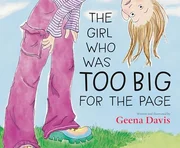
Sheila is the self-aware star of her own story. She’s “rather proud” of being “a girl who [lives] in a book,” since a captive audience will “read the book and wonder about her and want to know just what her deal” is. Pale-skinned with sandy-brown hair, Sheila hits developmental milestones: She walks, she talks, she starts kindergarten, and, as one generally does, she gets older—“exactly one year older for every year that [goes] by.” Then, a dramatic, off-page growth spurt “change[s] everything.” Readers can still see Sheila, “but only about up to her neck.” Sheila contorts herself to stay visible but becomes “very self-conscious.” It takes reassurance from a friend to remind her that “people are valuable and special no matter what’s different about them.” Davis’ watercolorlike illustrations feature pastel-hued portraits in occasionally clumsy proportions that vary little in perspective. The conflict is abruptly resolved, while the pseudo-meta construct of framing the moral within a picture book feels forced; the message for readers to be comfortable taking up space is far more capably accomplished in Vashti Harrison’s Caldecott Medal–winning Big (2023).


